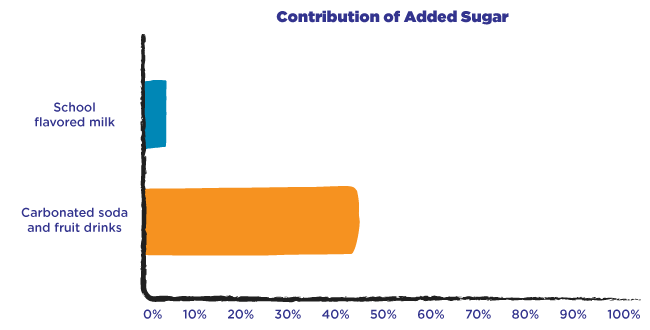Flavored Milk
Flavored milk is a crucial part of school nutrition. How do we know? Because schools that offer it see increased lunch participation, and kids who drink it have better overall diets. Plus, flavored milk in schools has less sugar than flavored milk in grocery stores.
Get schooled on the flavored milk facts.
Kids need the nutrients in milk.
Milk is the number one source for three of the four nutrients of concern that kids are lacking – calcium, vitamin D and potassium – according to the Dietary Guidelines for Americans. Drinking flavored milk can help children meet the recommendation for three daily servings of dairy foods while providing key nutrients necessary for growth and development. Additionally, kids who drink flavored milk consume more of these nutrients of concern compared to non-flavored milk drinkers.1
Three 8-ounce servings of milk, flavored or not, gives kids as much…
- Protein as four large hardboiled eggs
- Calcium as 38 cups of raw kale
- Vitamin D as a 6.5 oz can of sardines (approx. 15 sardines)
- Vitamin A as approx. 1.8 cups of fortified cereal
- Phosphorus as approx. 3 cups of cooked red kidney beans
- Riboflavin as 0.8 cups of whole almonds
Less sugar than you think.

Flavored milk in schools contributes very little added sugar to kids’ diets (6 grams, or about 4%), yet provides thirteen essential nutrients – compared to soda and fruit drinks that contribute lots of added sugar (45%) for little to no nutritional value.
Research has also shown that the tiny amount of added sugar in flavored milk does not affect behavior or contribute to hyperactivity in kids.2,3
Flavored milk drinkers are just as likely to maintain a healthy weight as other kids.
Children who drink flavored milk drink more milk overall, have better quality diets, do not have higher intakes of added sugar or fat, and are just as likely to be at a healthy weight when compared with kids who do not drink flavored milk.1
1% Flavored Milk
If you planned to serve 1% flavored milk this school year, you still can.
Meal pattern flexibility waivers due to COVID-19 allow schools to continue serving 1% flavored milk for the 2020-2021 school year. In some states this may require filling out an application. Check your local state agency website for more information or contact your Dairy MAX School Wellness Consultant for support.
Why continue to serve 1% flavored milk?
- Improving students’ overall milk experience through additional options, merchandising and more has been shown to increase average daily participation (ADP).4
- Milk’s unique nutrient package can be difficult to replace in a healthy eating pattern,5 so options that promote milk consumption could help close students’ nutrient gap.6
- School milk consumption may increase. Serving 1% flavored milk could reverse the decline in milk consumption observed by the USDA Food and Nutrition Service during lunch among elementary, middle and high school National School Lunch Program participants.
Click the top right playlist button for the full list of videos.
We can help.
- Consult with a school wellness expert
- See more research on flavored milk in schools
- Learn about chocolate milk for sports recovery
References


